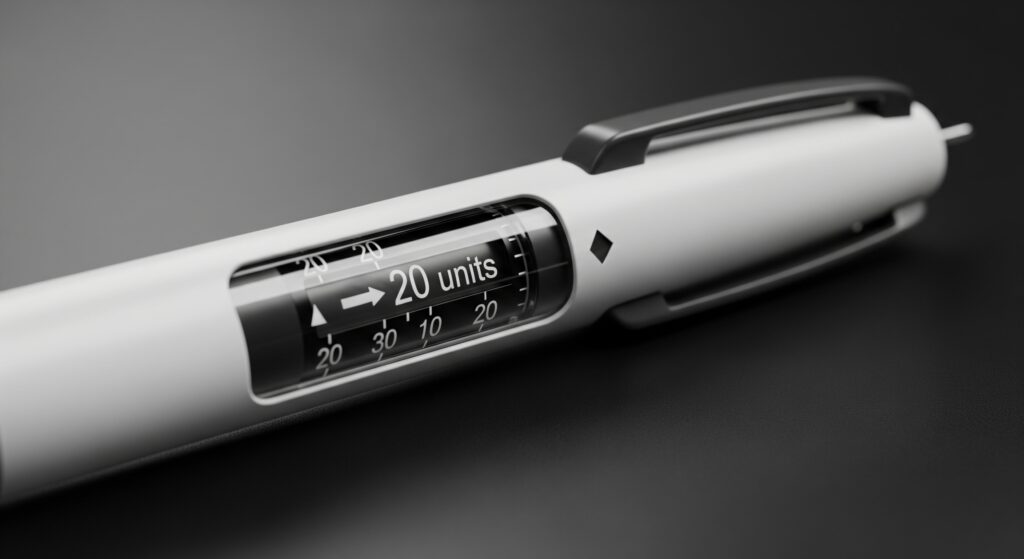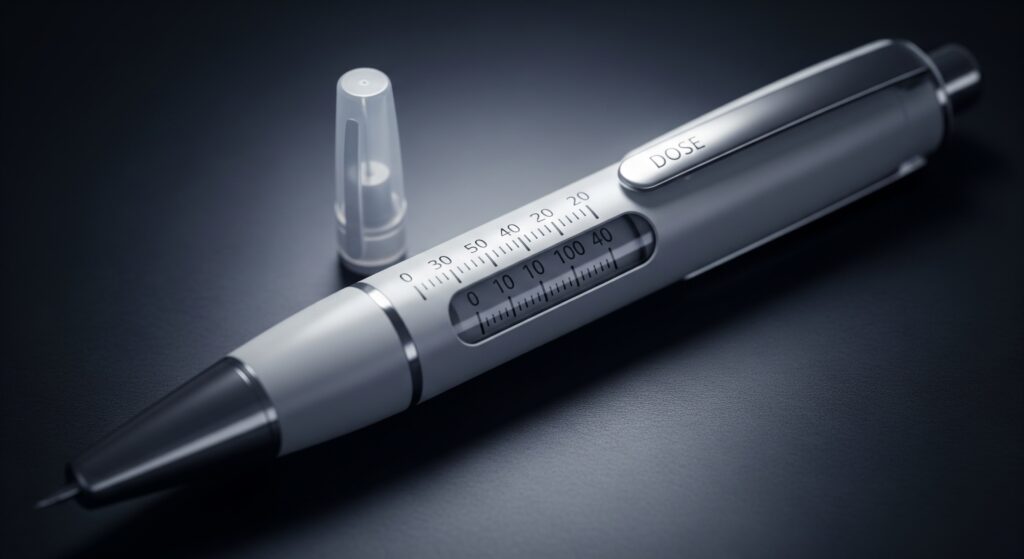
Use our Free Click-to-Dose calculator
General Information About Tirzepatide
Tirzepatide is a modern medication that has been extensively studied for its powerful effects on various health conditions, including obesity, type 2 diabetes, fatty liver disease (Metabolic Dysfunction-Associated Steatohepatitis or MASH), and obstructive sleep apnea (OSA). It is given as a once-weekly shot under the skin. Research into tirzepatide has significantly increased over the past few years, with many studies published and more expected to come out by 2025.
Tirzepatide is produced by the pharmaceutical company Eli Lilly and Company. It is the active ingredient in two of their major brand-name medications:
- Mounjaro®: Approved for the treatment of type 2 diabetes.
- Zepbound®: Approved for chronic weight management in adults with obesity or who are overweight with related health conditions.

How Tirzepatide is Typically Used (Dosing)
The medication is administered as a once-weekly injection under the skin. In most clinical trials, specific doses were used:
• The most common doses given to participants were 5 milligrams (mg), 10 mg, or 15 mg once a week.
• Often, treatment is started at a lower dose, such as 2.5 mg per week, and then gradually increased to the target dose. This gradual increase is often called “dose escalation.”
• For certain conditions, like obstructive sleep apnea combined with obesity, people might receive the maximum dose they can comfortably tolerate, which could be 10 mg or 15 mg.
What Tirzepatide is Good For (Key Benefits)
Tirzepatide has shown impressive results in several health areas, with its effectiveness often linked to the dose used:
• Significant Weight Loss and Obesity Management with Tirzepatide:
◦ It leads to substantial and lasting reductions in body weight for adults living with obesity.
◦ Continuing treatment helps people keep the weight off that they initially lost.
◦ Key Articles: The SURMOUNT trials (specifically SURMOUNT-1, SURMOUNT-2, SURMOUNT-4, and SURMOUNT-5) have extensively studied tirzepatide for weight loss in people with and without type 2 diabetes. For example, in SURMOUNT-1, participants received once-weekly doses of 5 mg, 10 mg, or 15 mg.
• Controlling Type 2 Diabetes:
◦ The medication is very effective at improving blood sugar control, as measured by a key indicator called HbA1c.
◦ The improvement in HbA1c can be dependent on the dose. For instance, in one study, HbA1c levels decreased by 1.87% with the 5 mg dose, 1.89% with 10 mg, and 2.07% with 15 mg.
◦ It also helps the pancreas work better and improves the body’s sensitivity to insulin.
◦ Key Articles: The SURPASS trials (like SURPASS-1 and SURPASS-5) investigated tirzepatide’s role in managing type 2 diabetes, sometimes comparing it directly to other diabetes medications.
• Improving Liver Health (Metabolic Dysfunction-Associated Steatohepatitis – MASH):
◦ For people with MASH (a type of fatty liver disease) and existing liver scarring (fibrosis), tirzepatide has shown promising results.
◦ In a study (SYNERGY-NASH), 55% of participants on 5 mg and 51% on 10 mg tirzepatide saw an improvement in their liver scarring without their MASH getting worse, which was significantly better than the 30% in the placebo group.
◦ Key Article: The SYNERGY-NASH trial specifically explored these benefits for liver health.
• Helping Obstructive Sleep Apnea (OSA) Combined with Obesity:
◦ The medicine has led to significant improvements in important measurements for individuals dealing with both obstructive sleep apnea and obesity.
◦ Participants in these studies received the maximum tolerated dose, either 10 mg or 15 mg.
◦ Key Article: The SURMOUNT-OSA trial specifically focused on this combined benefit.
• Overall Heart and Metabolism Improvements:
◦ Treatment with tirzepatide has been observed to lead to improvements in all measured factors related to heart health and metabolism.
What to Watch Out For (Side Effects)
Like any medication, tirzepatide can cause side effects. These are most commonly related to the digestive system and are often influenced by the dose:
• Most Common Side Effects are Digestive:
◦ The most frequently reported side effects are gastrointestinal, meaning they affect the stomach and gut.
◦ These events are typically mild to moderate in how severe they feel.
◦ They tend to occur more frequently during the initial phase when the dose is being gradually increased.
◦ Specific common digestive side effects reported include:
▪ Nausea (feeling sick to your stomach): Experienced by 17% to 22% of people.
▪ Diarrhea: Experienced by 13% to 16% of people.
▪ Vomiting: Experienced by 6% to 10% of people.
• Similar to Other Medications:
◦ When compared to semaglutide, another similar medication, tirzepatide’s safety profile, including the rates of these digestive side effects, was found to be similar.
• Few People Stop Treatment Due to Side Effects:
◦ In clinical trials, only a small percentage of people (less than 5%) stopped taking tirzepatide because of adverse events.
• Higher Doses May Raise Specific Concerns:
◦ While generally well-tolerated, some reviews note safety concerns, particularly with high-dose administration, regarding the potential for gastrointestinal side effects. This underscores why doctors typically start with lower doses and gradually increase them to find the right balance of benefit and tolerance.
In summary, tirzepatide is a highly effective medication for conditions like obesity and type 2 diabetes, offering significant health improvements often in a dose-dependent manner. While it has a generally favorable safety profile, its most common side effects are mild to moderate digestive issues, which are most noticeable during dose increases and should be monitored, especially at higher doses.
————————————————————-
References
• Aronne LJ, Sattar N, Horn DB, Bays HE, Wharton S, Lin WY, Ahmad NN, Zhang S, Liao R, Bunck MC, Jouravskaya I, Murphy MA; SURMOUNT-4 Investigators. Continued Treatment With Tirzepatide for Maintenance of Weight Reduction in Adults With Obesity: The SURMOUNT-4 Randomized Clinical Trial. JAMA. 2024 Jan 2;331(1):38-48. doi: 10.1001/jama.2023.24945. JAMA. 2024. PMID: 38078870
• Frías JP, Davies MJ, Rosenstock J, Pérez Manghi FC, Fernández Landó L, Bergman BK, Liu B, Cui X, Brown K; SURPASS-2 Investigators. Tirzepatide versus Semaglutide Once Weekly in Patients with Type 2 Diabetes. N Engl J Med. 2021 Aug 5;385(6):503-515. doi: 10.1056/NEJMoa2107519. Epub 2021 Jun 25. N Engl J Med. 2021. PMID: 34170647
• Jastreboff AM, le Roux CW, Stefanski A, Aronne LJ, Halpern B, Wharton S, Wilding JPH, Perreault L, Zhang S, Battula R, Bunck MC, Ahmad NN, Jouravskaya I; SURMOUNT-1 Investigators. Tirzepatide for Obesity Treatment and Diabetes Prevention. N Engl J Med. 2025 Mar 6;392(10):958-971. doi: 10.1056/NEJMoa2410819. Epub 2024 Nov 13. N Engl J Med. 2025. PMID: 39536238
• Jastreboff AM, Aronne LJ, Ahmad NN, Wharton S, Connery L, Alves B, Kiyosue A, Zhang S, Liu B, Bunck MC, Stefanski A; SURMOUNT-1 Investigators. Tirzepatide Once Weekly for the Treatment of Obesity. N Engl J Med. 2022 Jul 21;387(3):205-216. doi: 10.1056/NEJMoa2206038. Epub 2022 Jun 4. N Engl J Med. 2022. PMID: 35658024
• Garvey WT, Frias JP, Jastreboff AM, le Roux CW, Sattar N, Aizenberg D, Mao H, Zhang S, Ahmad NN, Bunck MC, Benabbad I, Zhang XM; SURMOUNT-2 investigators. Tirzepatide once weekly for the treatment of obesity in people with type 2 diabetes (SURMOUNT-2): a double-blind, randomised, multicentre, placebo-controlled, phase 3 trial. Lancet. 2023 Aug 19;402(10402):613-626. doi: 10.1016/S0140-6736(23)01200-X. Epub 2023 Jun 26. Lancet. 2023. PMID: 37385275
• Aronne LJ, Horn DB, le Roux CW, Ho W, Falcon BL, Gomez Valderas E, Das S, Lee CJ, Glass LC, Senyucel C, Dunn JP; SURMOUNT-5 Trial Investigators. Tirzepatide as Compared with Semaglutide for the Treatment of Obesity. N Engl J Med. 2025 Jul 3;393(1):26-36. doi: 10.1056/NEJMoa2416394. Epub 2025 May 11. N Engl J Med. 2025. PMID: 40353578
• Malhotra A, Grunstein RR, Fietze I, Weaver TE, Redline S, Azarbarzin A, Sands SA, Schwab RJ, Dunn JP, Chakladar S, Bunck MC, Bednarik J; SURMOUNT-OSA Investigators. Tirzepatide for the Treatment of Obstructive Sleep Apnea and Obesity. N Engl J Med. 2024 Oct 3;391(13):1193-1205. doi: 10.1056/NEJMoa2404881. Epub 2024 Jun 21. N Engl J Med. 2024. PMID: 38912654
• Rosenstock J, Wysham C, Frías JP, Kaneko S, Lee CJ, Fernández Landó L, Mao H, Cui X, Karanikas CA, Thieu VT. Efficacy and safety of a novel dual GIP and GLP-1 receptor agonist tirzepatide in patients with type 2 diabetes (SURPASS-1): a double-blind, randomised, phase 3 trial. Lancet. 2021 Jul 10;398(10295):143-155. doi: 10.1016/S0140-6736(21)01324-6. Epub 2021 Jun 27. Lancet. 2021. PMID: 34186022
• Loomba R, Hartman ML, Lawitz EJ, Vuppalanchi R, Boursier J, Bugianesi E, Yoneda M, Behling C, Cummings OW, Tang Y, Brouwers B, Robins DA, Nikooie A, Bunck MC, Haupt A, Sanyal AJ; SYNERGY-NASH Investigators. Tirzepatide for Metabolic Dysfunction-Associated Steatohepatitis with Liver Fibrosis. N Engl J Med. 2024 Jul 25;391(4):299-310. doi: 10.1056/NEJMoa2401943. Epub 2024 Jun 8. N Engl J Med. 2024. PMID: 38856224
• Dahl D, Onishi Y, Norwood P, Huh R, Bray R, Patel H, Rodríguez Á. Effect of Subcutaneous Tirzepatide vs Placebo Added to Titrated Insulin Glargine on Glycemic Control in Patients With Type 2 Diabetes: The SURPASS-5 Randomized Clinical Trial. JAMA. 2022 Feb 8;327(6):534-545. doi: 10.1001/jama.2022.0078. JAMA. 2022. PMID: 35133415
• Heise T, Mari A, DeVries JH, Urva S, Li J, Pratt EJ, Coskun T, Thomas MK, Mather KJ, Haupt A, Milicevic Z. Effects of subcutaneous tirzepatide versus placebo or semaglutide on pancreatic islet function and insulin sensitivity in adults with type 2 diabetes: a multicentre, randomised, double-blind, parallel-arm, phase 1 clinical trial. Lancet Diabetes Endocrinol. 2022 Jun;10(6):418-429. doi: 10.1016/S2213-8587(22)00085-7. Epub 2022 Apr 22. Lancet Diabetes Endocrinol. 2022. PMID: 35468322
• Yao H, Zhang A, Li D, Wu Y, Wang CZ, Wan JY, Yuan CS. Comparative effectiveness of GLP-1 receptor agonists on glycaemic control, body weight, and lipid profile for type 2 diabetes: systematic review and network meta-analysis. BMJ. 2024 Jan 29;384:e076410. doi: 10.1136/bmj-2023-076410. BMJ. 2024. PMID: 38286487
Use our Free Click-to-Dose calculator

